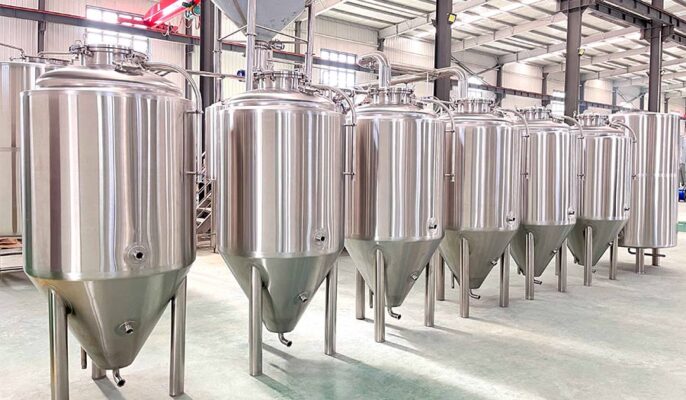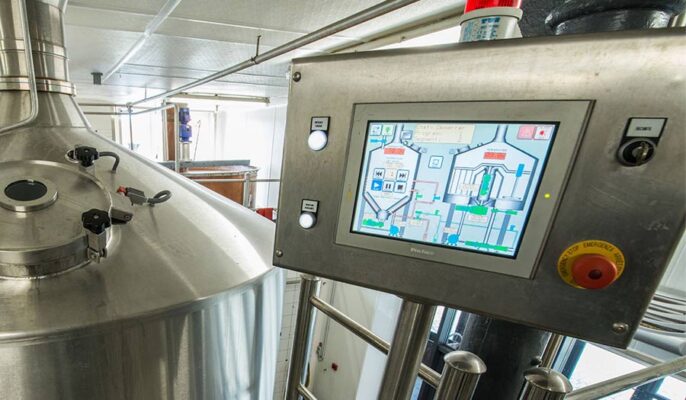Контроль температуры - это фундаментальный аспект процесса пивоварения, который играет жизненно важную роль в обеспечении качества и стабильности конечного продукта. Контроль температуры на каждом этапе процесса пивоварения - от затирания до брожения и дображивания - напрямую влияет на вкус, аромат и общие характеристики пива или другого напитка. Стабильная температура обеспечивает последовательность процесса пивоварения, уменьшает отклонения от партии к партии и гарантирует, что каждая бутылка пива будет иметь ожидаемый вкус и качество.
Зачем контролировать температуру брожения?
Контроль температуры брожения - это, пожалуй, самый важный шаг в достижении наибольшего прогресса в приготовлении пива. Проще говоря, типичные пивные дрожжи лучше всего работают в диапазоне 66-72°F. Это оптимальная температура, при которой дрожжи выполняют свою работу, не создавая слишком много нежелательных привкусов. Дрожжи процветают при более высоких температурах, но при этом они быстрее размножаются и производят больше эфиров.
Неприятные привкусы часто связаны с неконтролируемой температурой ферментации:
- Фюзеляжные спирты: часто воспринимается как острый алкогольный привкус, почти похожий на вкус вина или водки, но этот привкус обычно исчезает в процессе выдержки.
- Эстеры: Часто воспринимаются как фруктовые, банановые, грушевые ароматы или ароматы жидкости для снятия лака. Хотя некоторые эстеры приветствуются в определенных стилях, например, в пшеничном пиве, они часто попадают туда, куда не следует. Эстеры уменьшаются во время выдержки, но передозировка может не улучшиться со временем.
- Ацетальдегид: часто воспринимается как зеленое яблоко, сырая тыква или цуккини. Ацетальдегид - естественный побочный продукт любого брожения, но в неконтролируемых условиях он может присутствовать в избытке.

Как достигается охлаждение сусла?
Большинство пивоваренных заводов охлаждают сусло с помощью одно- или двухступенчатых пластинчатых теплообменников. Это требовательная система: необходимо отвести от процесса большое количество тепла. Смесь гликоля с водой в водяном контуре усиливает эффект охлаждения. Для предотвращения загрязнения сусла и охлаждающей жидкости часто выбирают теплообменники с двойными стенками пищевого класса.
Факторы, которые необходимо учитывать:
- Общее количество охлаждаемого сусла (обычно выражается в BBL/объеме бочки).
- Необходимое время выбивания (время охлаждения, необходимое для оптимизации процесса).
- Начальная температура сусла и желаемая конечная температура сусла.
- Может ли чиллер также обеспечивать охлаждение других процессов пивоварения?
Роль контроля температуры в процессе пивоварения
Затирание
Во время затирания измельченные зерна смешивают с горячей водой, чтобы извлечь из них ферментируемые сахара и получить сахаристую жидкость, называемую суслом. Температура затирания влияет на тип и количество выделяемых сахаров. Более низкие температуры способствуют образованию большего количества ферментируемых сахаров, в результате чего пиво получается более сухим и разбавленным. Более высокие температуры способствуют образованию меньшего количества ферментируемых сахаров, в результате чего пиво получается более сладким и насыщенным. Точный контроль температуры очень важен при затирании для достижения желаемого состава сусла и обеспечения надлежащей основы для остального процесса пивоварения.
Кипячение
После затирания сусло кипятят, чтобы стерилизовать его, и добавляют хмель для придания горечи, вкуса и аромата. Продолжительность и интенсивность процесса кипячения влияют на конечную горечь и характер пива. Контроль температуры в процессе кипячения помогает предотвратить чрезмерную карамелизацию и обеспечивает постоянный профиль горечи.
Ферментация
Брожение - важный этап, на котором дрожжи потребляют сахара, содержащиеся в сусле, производя спирт и углекислый газ. Температура брожения существенно влияет на поведение дрожжей, в результате чего образуются различные эфиры и другие ароматические соединения. Контроль температуры здесь очень важен, поскольку различные штаммы дрожжей имеют определенные температурные диапазоны, в которых они работают лучше всего. Слишком высокая или слишком низкая температура может привести к появлению посторонних привкусов, застою брожения или чрезмерной активности дрожжей, что может негативно сказаться на вкусе и аромате пива.
Кондиционирование
После брожения пиво необходимо кондиционировать, чтобы дать возможность аромату созреть и развиться дальше. В процессе кондиционирования необходимо контролировать температуру, чтобы способствовать протеканию необходимых химических реакций, включая распад нежелательных соединений и образование желаемых вкусовых соединений. Правильный контроль температуры гарантирует, что пиво достигнет желаемого вкусового профиля и прозрачности.

Почему контроль температуры важен в процессе ферментации пива?
Контроль температуры во время ферментации
Сбраживание пива при правильной температуре помогает дрожжам превращать сахара в алкоголь, в результате чего получается вкусное пиво с сильным ароматом. Если температура слишком высока или слишком низка, дрожжи могут стать вялыми или полностью погибнуть, и тогда они не смогут работать должным образом.
Низкие температуры также могут привести к повышению кислотности пива, а высокие - к появлению посторонних привкусов, таких как эфиры и фузелиновое масло. Поэтому очень важно внимательно следить за температурой брожения сусла на протяжении всего процесса пивоварения.
Формирование вкуса и аромата пива
Температура брожения оказывает значительное влияние на вкус и аромат пива. При разных температурах получаются разные вкусовые компоненты пива. При правильной температуре дрожжи могут быстро и полностью превратить сахара в спирт и углекислый газ, тем самым повышая эффективность брожения и увеличивая выход пива. Если температура слишком высока, дрожжи могут потерять активность из-за перегрева; если температура слишком низкая, скорость брожения замедлится и даже может привести к неполному брожению. При варке пива контроль температуры имеет решающее значение для формирования вкуса и аромата. Он не только влияет на активность пива, но и напрямую связан с различными ароматическими соединениями, образующимися в процессе брожения.
Повышение эффективности пивоварения
Точный контроль температуры брожения позволяет обеспечить стабильность и предсказуемость процесса пивоварения, что повышает эффективность производства и снижает производственные затраты. В то же время высококачественные вина могут принести большую рыночную стоимость и экономическую выгоду.
Как добиться точного контроля температуры?
- Теплообменники: Теплообменники используются для быстрого охлаждения сусла после кипячения, останавливая ферментативные реакции и снижая риск появления посторонних привкусов. Противоточные или пластинчатые теплообменники широко распространены на пивоварнях, они передают тепло от горячего сусла к холодной воде, сохраняя их раздельными.
- Регуляторы температуры: Контроллеры температуры - это устройства, регулирующие работу бродильных емкостей и контролирующие температуру в них. Они поддерживают температуру в определенном диапазоне, позволяя пивоварам регулировать процесс брожения в соответствии с оптимальным температурным режимом дрожжей. Регуляторы температуры обеспечивают точность и стабильность, что снижает риск появления посторонних привкусов или застоя брожения.
Советы по контролю температуры
Повышение температуры брожения
- Заверните ферментер во что-то вроде спального мешка или утепленного одеяла. Обертывание ферментера задерживает тепло, выделяемое дрожжами при брожении, что приводит к повышению температуры.
- Для достижения аналогичного эффекта поместите ферментер в картонную коробку или изолированное помещение.
- Другой способ контроля температуры - погрузить ферментер в ведро с водой и использовать для поддержания температуры обогреватель аквариумного типа.
Снижение температуры брожения
- Самый простой способ - завернуть ферментер во влажное полотенце. По мере испарения воды внешняя поверхность ферментера охлаждается.
- Если это не помогает, можно поместить ферментер в воду на 1-2 дюйма и обернуть его влажным полотенцем, следя за тем, чтобы полотенце касалось воды. Это обеспечит постоянный приток влаги для испарения.
- Вы также можете добавить в воду кубики льда или включить вентилятор, чтобы еще больше охладить воду. Можно также погрузить графин в ведро с водой и использовать пакет со льдом, чтобы снизить температуру. Для поддержания постоянной температуры необходимо регулярно менять пакет со льдом.

ЧАСТО ЗАДАВАЕМЫЕ ВОПРОСЫ
Почему необходимо контролировать температуру в процессе ферментации?
В процессе ферментации температура является ключевым фактором, влияющим на активность микроорганизмов, скорость метаболизма и качество продуктов ферментации. Различные микроорганизмы имеют свои оптимальные температурные диапазоны для роста и ферментации. Только при подходящей температуре микроорганизмы могут быстро размножаться и эффективно превращать субстраты в желаемые продукты.
Как определить оптимальную температуру в процессе ферментации?
Чтобы определить оптимальную температуру в процессе ферментации, необходимо учитывать множество факторов, включая виды микроорганизмов, характеристики субстрата, условия процесса ферментации и т.д.
Как добиться точного контроля температуры ферментации?
Для точного контроля температуры ферментации необходимо современное оборудование и технологии контроля температуры. К обычному оборудованию для контроля температуры относятся инкубаторы с постоянной температурой, емкости для ферментации и т. д. Эти устройства обычно оснащены точными температурными датчиками и системами управления, которые могут контролировать и регулировать температуру ферментационной жидкости в режиме реального времени.




